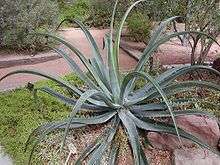Agave vilmoriniana
| Agave vilmoriniana (Octopus agave) | |
|---|---|
 | |
| Grown as an ornamental plant. | |
| Scientific classification | |
| Kingdom: | Plantae |
| Clade: | Angiosperms |
| Clade: | Monocots |
| Order: | Asparagales |
| Family: | Asparagaceae |
| Subfamily: | Agavoideae |
| Genus: | Agave |
| Species: | A. vilmoriniana |
| Binomial name | |
| Agave vilmoriniana Berger | |
| Synonyms[1] | |
| |
Agave vilmoriniana, sometimes misspelled vilmoriana, and popularly known as Octopus agave, is a species of agave endemic to Mexico. It is known for its untoothed arching and twisting leaves.[2]
Taxonomy
Wild plants had been found in 1899 by Joseph Nelson Rose near Guadalajara, Jalisco. The species was named by Alwin Berger in 1913 in honor of Maurice de Vilmorin, based on specimens collected by Leon Diguet and grown at the Jardin des Plantes in Paris.[3]
Distribution
In nature, the octopus agave prefers the cliffs of barrancas of southern Sonora, Chihuahua, Sinaloa, Jalisco, Durango, Nayarit and Aguascalientes, typically between elevations of 600 to 1,700 meters.[4]
Uses
Agave vilmoriniana has one of the highest concentrations of the sapogenin smilagenen, and in parts of Mexico the leaves are cut, dried, and the fibers are beaten to make them into a brush with built-in soap.
The "octopus agave" is cultivated as an ornamental plant for planting in gardens and containers.
See also
- Endemic flora of Mexico
| Wikimedia Commons has media related to Agave vilmoriniana. |
References
- ↑ The Plant List
- ↑ Howard Scott Gentry, Agaves of Continental North America (University of Arizona Press, 1982) pp. 82-85
- ↑ Alwin Berger, Die Agaven, Jena, 1915.
- ↑ CONABIO. 2009. Catálogo taxonómico de especies de México. 1. In Capital Nat. México. CONABIO, Mexico City.